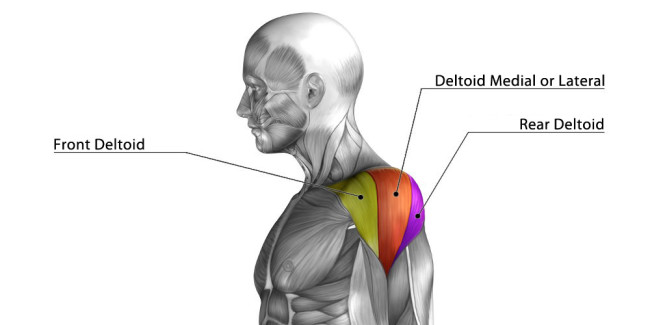Broad and muscular shoulders are the epitome of physique & overall personality. A frame with wide shoulders and narrow waist is the most desirable trait in people who lift, and the very base of the attractive ‘V-taper’.
Your shoulder muscles, or deltoids, consist of three distinct sets of muscles: the anterior deltoid, middle deltoid, and posterior deltoid. Then there are the rotator cuff muscles, which are located underneath the deltoid muscles, and aren’t visible.

Remember that whenever we lift, all three muscles of the shoulder work synergistically. You can’t isolate a muscle as a lot of people claim. Any exercise you do of the shoulder, will target all the 3 heads.
However, there are exercises, which activate particular muscles better than the other. That is the reason, a workout should be a mix of different movements, targeting the complete musculature.
There are number of different exercises which you can perform in the gym to build up your shoulders, but research has identified certain movements, which activate each head of the shoulder, better than the others. Knowing these movements, will help you save time, and design a better strength & hypertrophy program for yourself or your clients.
These studies have tested, the EMG, MVC (Maximum Voluntary Contraction), and Mean & Peak Activation, of the muscle.
A study, tested app. 27 different movements for traps & shoulders, and found that the best exercises for each head are:
Front Delt
Mean: Seated Behind Neck Press, Seated Military Press, Incline Press
Peak: Seated Behind Neck Press, Standing Dumbbell Military Press, Incline Press
Mid Delt
Mean: Band Face Pull, Lateral Raise, Seated Behind Neck Press
Peak: Band Face Pull, Lateral Raise, Cable Lateral Raise
Rear Delt
Mean: Band Face Pull, Bent Over Rear Delt Raise, Prone Rear Delt Raise
Peak: Band Face Pull, Bent Over Rear Delt Raise, Hanging Row
Another analysis, found the following exercises to be the best of each head:
Front Delt: seated dumbbell shoulder press, seated barbell shoulder press, standing dumbbell shoulder press, standing barbell shoulder press, seated Arnold press.
Middle Delt: standing dumbbell shoulder press, standing barbell shoulder press, dumbbell lateral raises, lying incline lateral raise, cable lateral raise
Rear Delt: cable rear delt flyes, reverse pec dec flyes, cable wide grip rear delt row, chest supported dumbbell rear delt row, bent over reverse dumbbell flyes.
Another study, compiled a list of the 10 exercises most often performed by both recreational lifters and athletes and most commonly prescribed by trainers. The list included the dumbbell shoulder press, push-up, cable diagonal raise, dips, dumbbell front raise, battling ropes, barbell upright row, bent-arm lateral raise, 45-degree incline row and seated rear lateral raise.
Researchers found that, For targeting the anterior deltoid, the dumbbell shoulder press & dumbbell front raise elicited significantly higher muscle activation than any other exercise tested. For the medial deltoid, two exercises came out on top: the 45-degree incline row and the bent-arm lateral raise. Finally, for the posterior deltoid, researchers found that the seated rear lateral raise and the 45-degree incline row both provided the greatest muscle activation for the back of the shoulder.

Front Delt: Seated & Standing Barbell & Dumbbell Press, Arnold Press, dumbbell/barbell/cable front raise, seated behind neck press
Middle Delt: Dumbbell & Cable Lateral Raise, Pronated Lying Incline Lateral Raise, seated behind neck press
Rear Delt: Reverse Pec Dec Flyes, Bent Over Reverse Dumbbell Flyes, Pronated Lying Rear Delt Raise, Pronated 45deg Incline Row



